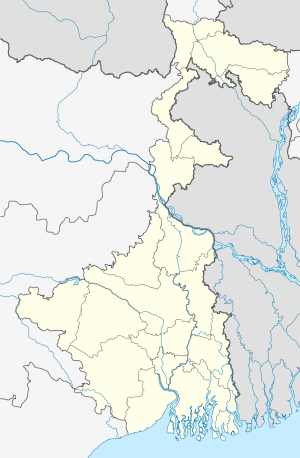Basirhat
| Basirhat বসিরহাট | |
|---|---|
| city | |
 Basirhat Location in West Bengal, India | |
| Coordinates: 22°39′26″N 88°53′39″E / 22.65722°N 88.89417°ECoordinates: 22°39′26″N 88°53′39″E / 22.65722°N 88.89417°E | |
| Country |
|
| State | West Bengal |
| District | North 24 Parganas |
| Government | |
| • Municipality Chairman | TAPAN [1] |
| Elevation | 6 m (20 ft) |
| Population (2011) | |
| • Total | 144,891 |
| Languages | |
| • Official | Bengali, English |
| Time zone | IST (UTC+5:30) |
| PIN | 743411 |
| Area code(s) | 3217 |
| Lok Sabha constituency | Basirhat |
| Vidhan Sabha constituency | Basirhat Dakshin, Basirhat Uttar |
| Website |
basirhat |
Basirhat is a city and a municipality in North 24 Parganas district of West Bengal, India. It is located on the bank of Ichamati (Ichhamati) River.

Administrative Area
Basirhat subdivision was formed on 1 January 1861 as per a Government order and it consisted of Balia Pargana's Basurhāt, Kalingā, Hāruā and Husenābād Police Stations. Previously, Basirhat was under the jurisdiction of Barasat sub-division and was named as Basurhāt till 1896. Basirhat municipality was established on 1 April 1869 and it is divided into 23 wards covering an area of 22.5 km².
Demographics
As per the 2011 census, Basirhat Urban Agglomeration had a population of 144,891, out of which 73,491 were males and 71,400 were females. The 0–6 years population was 12,578. Effective literacy rate for the 7+ population was 86.88 per cent.[2] Bengali is the principal language spoken in the area.
Etymology
The sources which are considered till now behind the naming of Basirhat are as follows:
- Bahurhāt—market for various items
- Banserhāt—market for buying and selling bamboos
- Bastirhāt—low land market
- Bashir er hat or Bose er hat—the name of the owner of the market
- Old Bengali word Bashir (বশির) means salt (সামুদ্রিক লবণ) .There was a big market of salt and so the place became famous as BASHIR HAT(বশিরহাট,HAT= market).After a long time word 'BASHIRHAT' became 'BASIRHAT' (বসিরহাট).
Economy
Agriculture is the main source of income though other industries like brick making,Gamcha,Nolen Sandesh and fisheries are also dominant in this area.
Education
Some of the schools of Basirhat are:
- Barajirakpur Tarun Sangha High School (H.S.)
- Basirhat Baroda Prosad Vidyapith Girl's High School
- Basirhat Town High School
- Basirhat H.M.D. Girls' High School
- Basirhat High School
- Basirhat P.C.M. Girls' High School
- Bhabla Lady Mukharjee Girls' High School
- Bhabla Tantra Sir Rajendra High School
- Dandirhat N.K.U.S. Niketan HS
- Gokna Sri Gobindapur F.P School
- Itinda Union High School
- Madhyampur Gulaichandi High School
- Panchanan Dalal Institution
- Panitor High School
- Shibati High School

History
Basirhat has a long history of farmer's movements like the Tebhaga movement. Freedom fighter Dinesh Chandra Majumder was born here in 1907. Noted industrialist, Sir Rajen Mukherjee[3][4] was born at Bhabla (also spelt Bhyabla) near Basirhat.
Health issues
Basirhat is one of the areas where ground water is affected by arsenic contamination.[5]
Transportation
Railways
Basirhat was connected with Barasat by the narrow gauge Barasat Basirhat Railway operated by Martin's Light Railways. It was closed down in 1955 and subsequently converted to broad gauge. The railway tracks in the region have been electrified and there are EMUs services to Sealdah and Hasnabad provided by the Kolkata Suburban Railway.
Roadway
Bus services to Kolkata and other places are available.
Private Buses
- 72 Basirhat - Nazat
- 72A Basirhat - Dhamakhali
- 252 Hasnabad - Barasat - Esplanade
- 253 Basirhat - Barasat - Esplanade
DN Series of Routes
- DN12 Bongaon – Basirhat
- DN12/1 Habra – Nazat
- DN18 Shyambazar – Basirhat
- DN38 Taranipur – Malancha
- DN42 Barasat - Dhamakhali
MM Series of Routes
- MM7 Nabatkati - Dhamakhali STA Bus Routes
- Basirhat - Garia Bus Stand
- Basirhat – Gadiara
- Hasnabad - Bandel
References
- ↑ Official District Administration site Archived August 20, 2010, at the Wayback Machine.
- ↑ "Urban Agglomerations/Cities having population 1 lakh and above" (PDF). Provisional Population Totals, Census of India 2011. Retrieved 2011-10-21.
- ↑ Sengupta, Subodh Chandra and Bose, Anjali, p 470.
- ↑ Bhabla
- ↑ "Groundwater Arsenic contamination in West Bengal-India (19 years study )". Groundwater arsenic contamination status of North 24-Parganas district, one of the nine arsenic affected districts of West Bengal-India. SOES. Archived from the original on 27 September 2007. Retrieved 2007-08-24.